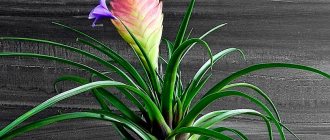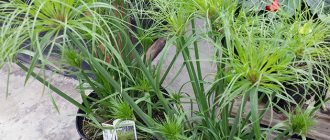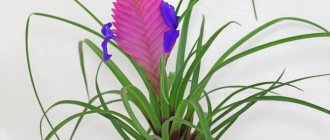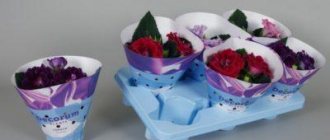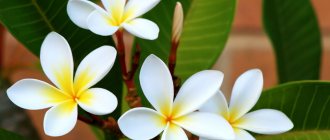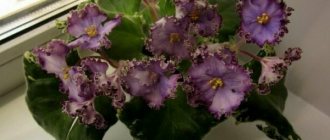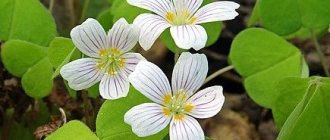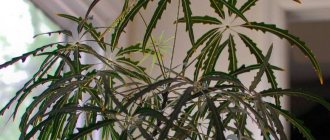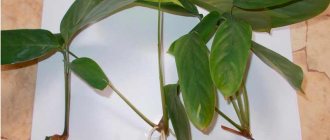This genus of herbaceous plants, like tillandsia, is quite interesting and popular in home floriculture. It is directly related to the bromeliad family. There are about 500 species in this genus. Wildflowers are found in subtropical and tropical regions of South and Central America. They grow most readily in coastal areas, in damp forests and on mountain slopes where there is sufficient rainfall.
Tillandsia has long been popular with both amateurs and professional gardeners. This is due to the fact that in this genus there are plants with bizarre and very bright shapes and colors. Some plants resemble a ball of thread, a silver beard, a tuft of feathers, or even an ear of grain.
Tillandsias are grown as epiphytes. Driftwood or a very loose substrate consisting of moss and tree bark is suitable for their placement. The root system of this plant species serves to attach to the bark of a tree or a cut branch. They receive moisture and all the nutrients they need for normal growth and development from the air. This is why it is so important to provide the plant with high air humidity.
Tillandsias are almost impossible to describe due to their varied appearance.
However, they can be divided into two groups.
Kinds
Anita (Tillandsia cyanea 'anita triflor')
Anita (Tillandsia cyanea 'anita triflor')
Hybrid of Tillandsia blue. Low decorative appearance, basal leaves, long, dark gray in color. The inflorescence is spike-shaped, flat, wide, formed from blue three-petal flowers of juicy pink bracts. Peduncle short.
Usneoides (Tillandsia usneoides)
Tillandsia usneoides
It is the most popular type of atmospheric tillandsia. The stems are thin, their length can be several meters, the leaves are thread-like, up to 4.5 cm long and up to 9 mm wide, arranged in two rows. There is no root system, the plant grows on trees, rocky forms, branches, hanging from there like a lacy waterfall. The flowers are light-yellow.
Blue Cyanea (Tillandsia cyanea)
Tillandsia cyanea
Refers to herbaceous or green tillandsias. The leaves are narrow, leathery, can grow up to 29 cm in length, form a rosette, in the middle of which an inflorescence is formed in the shape of a flattened spike. The bracts are a juicy pink shade, the flowers are small, blue-lilac in color, bloom for 1 day.
Violetflower (Tillandsia ionantha)
Tillandsia ionantha
Belongs to the atmospheric Tillandsia group, looks exotic, similar to corals. The leaves are curved, form small rosettes, the inflorescences are blue-lilac, spicate. During flowering, the upper leaves in the rosette acquire a red tint.
Xerographics (Tillandsia xerographica)
Tillandsia xerographica
Xerophyte has the property of accumulating moisture and using it sparingly; it does not require a soil substrate. The height can reach 50 cm, the hard succulent leaf plates are covered with trichome scales, which reflect the sun's rays, protecting against burns, and also promotes the adsorption and retention of water. The peduncle is branched, the inflorescences are spike-shaped, the leaf bracts are pink, the floral bracts are yellow-green, the flowers are tubular, of a lilac hue.
Tillandsias, green or potted
They look like familiar plants grown indoors. Their leaves are collected in a rosette, and they can be elongated triangular or linear. Under natural conditions, they prefer to grow in the lower tier of the forest on the ground surface or on fallen trees. Grows in shady places. These plants are popular due to their unusual spike-shaped inflorescences.
The most popular tillandsias, which are grown indoors, have inflorescences in the form of a two-row spike. There are complex as well as simple inflorescences, consisting of several or one ear, which can be loose or very dense. Most often, stipules are arranged in a tile or spiral pattern. Gray tillandsias have a reduced inflorescence and only one flower is clearly visible.
Tillandsia cyanea Pink quill plant
Home care
Soil and fertilizers
For growing potted species, a loose, drained, coarse-fiber substrate is used. In summer and spring, namely every 14 days, tillandsia is fed using the foliar method. For fertilizing, use special microfertilizers for orchids or flowering plants.
Temperature
During the daytime it is +25…+27 degrees, at night – about +17 degrees.
Lighting
Diffused, without direct rays of the sun. Plants with gray succulent leaves need more light, while green tillandsias need light partial shade.
Watering and humidity
Plants are immersed in warm soft water or sprayed for 25 minutes 2-3 times a week. Water should not accumulate in the axils of the leaves. The optimal air humidity is high – 70-80%.
Transfer
In the spring, once every 2-3 years, species with green leaves need to be replanted. The container is selected to be low and wide, and a drainage layer is placed on its bottom. Atmospheric tillandsias are attached with a ribbon of cut nylon tights to beautiful stones, roots, baskets, etc.
Flowering, flower pruning
Flowering of potted species occurs in the summer - a tall pink spike-shaped peduncle is formed. The plant is an annual and gradually dries out after flowering. The peduncle does not need to be cut; babies form on it. When they are about 10 cm, you need:
- carefully separate from the mother plant and transplant into individual containers;
- if 1-2 babies have formed, leave them on the mother plant, which will dry out, and a new plant will continue to grow and develop in the container.
Tillandsia transplantation, containers and substrate
Only containers whose width exceeds their height are suitable for tillandsias. Plants develop specifically, growth and daughter rosettes replace the mother ones and growth occurs mainly in width. The root system of tillandsias is powerful, but not voluminous, and in deep containers the plant may suffer from waterlogging and disruption of comfortable conditions.
The substrate for these plants is chosen from among loose, well-drained soil mixtures with a coarse fibrous texture. For tillandsias, special soil mixtures for bromeliads or orchids are ideal, but you can make your own soil based on equal parts of deciduous soil, humus and peat with the addition of sphagnum, fern roots and pine bark.
Replanting for epiphytic species is not carried out at all (they are sold attached to a stone, bark or tree and grown on the same basis without changing), and for potted species it is carried out only after the volume of the bushes completely fills the free space (the plant grows in width to the walls of the pot , and the roots will begin to peek out of the water drainage holes). Potted tillandsia can remain in one container for 2-3 years, during which time it is only necessary to replace the top layer of soil annually in early spring.
If replanting is necessary, the plant is removed very carefully, carefully replacing the soil, trying not to injure even the slightest roots. The rhizome does not hold Tillandsia well in a loose substrate, so it is necessary to compact and crush the soil, paying attention to making the rosette of leaves stable.
Blue Tillandsia (Tillandsia cyanea). © Anita Sheffield
Reproduction methods
Seeds
Seed material is laid out on the surface of a moistened substrate consisting of peat and sand, covered with glass or film, and placed in a place with good lighting and a temperature of about +25 degrees. After 30 days, the seeds germinate.
Children
During flowering, the plant forms children - side shoots. When they form their roots and grow to 10 cm, they are transplanted from the mother plant into a mixture of sand and peat (1:1). After 2-3 months, they are transplanted into a substrate for orchids.
Plant height
The variety available means height and width may vary slightly between plants. However, air plants are generally not large indoor plants, and they probably won't grow much larger than what you have when you first buy them.
Possible problems
The main difficulties when growing tillandsia:
- gray and brown spots on leaf blades indicate a fungal infection. The plant is treated with a fungicide;
- white coating on the leaves, the plant withers - hard or cold irrigation water was used;
- leaf blades turn yellow, curl, die - a signal of insufficient watering;
- loss of foliage, loss of turgor, delayed flowering indicate a sharp change in temperature or lighting;
- the tips of the leaf blades acquire a brown tint - the temperature in the room is too low, or watering was carried out unevenly;
- the leaf blades turn brown, the rosette falls apart - excessive watering.
Fertilizers
Some fertilizers are made specifically for air plants, and feeding Tillandsia violetflower with one of these fertilizers every two weeks to once a month can be beneficial during the summer months.
Enthusiasts report good results when adding organic fertilizers made from fish emulsion to fog spray.
Diseases and pests
The plant can be attacked by bromeliad scale insects. They fight it with a soap solution or remove the pest from the leaf blades. Parts of the plant damaged by fungal or viral infections must be removed, and the flowerpot must be treated with a fungicide solution.
This plant is called the exotic among exotics. Due to its catchy and very unusual appearance in the interior of the room, tillandsia attracts everyone's attention. In order to grow such a beauty at home, you need to make some effort, but it is worth it.
Light
Proper lighting is one of the key factors in good air plant care. Indirect light is Tillandsia violetflower's best friend. If you place them somewhere in full sun during the day, they may become too dry and the leaves may scorch, especially if humidity levels are low.
They are a great addition to office environments due to their love of fluorescent lighting.
However, if the light is not bright enough, they are unlikely to bloom.
Pest protection
Tillandsia is affected by fungi, aphids, and spider mites. First, you can try to remove the insects manually using a cotton pad moistened with an aqueous-alcohol solution. After you treat the plant, check its leaves daily. When the pests appear again, spray with liquid preparations Actellik, Mospilan. Check all leaves again after 5 days. If the pests remain, repeat the treatment.
Growing bromeliads is a fascinating, but relatively troublesome activity. Although among the species of this interesting family there are plants that are easy to care for even for beginners in indoor floriculture. Epiphytic tillandsia does not need a substrate to grow; just attach a rosette of leaves to a piece of decorative bark or hang it in a bright corner of the room, then spray it to increase humidity. Tillandsia species grown in a pot with substrate are also original. You should take into account the needs of the plant in order to admire the attractive leaves and spectacular inflorescences longer.
Varieties of Tillandsia violetflower
Given its popularity, it is not surprising that there is a wide variety of Tillandsia violetflowers to choose from.
Some of the unique types include:
- 'Feugo' - This species is known for the dark red foliage that develops when the plant receives enough sun. They also grow in dense clumps.
- 'Rubra' is a small variety that grows more widely in its soft form. It also comes in a hard form that has straighter leaves.
- 'Maxima' - Tillandsia violetflowers are not large air plants, but 'Maxima' is significantly larger than the average variety and can also tolerate more direct sun.
